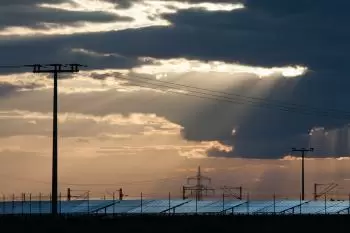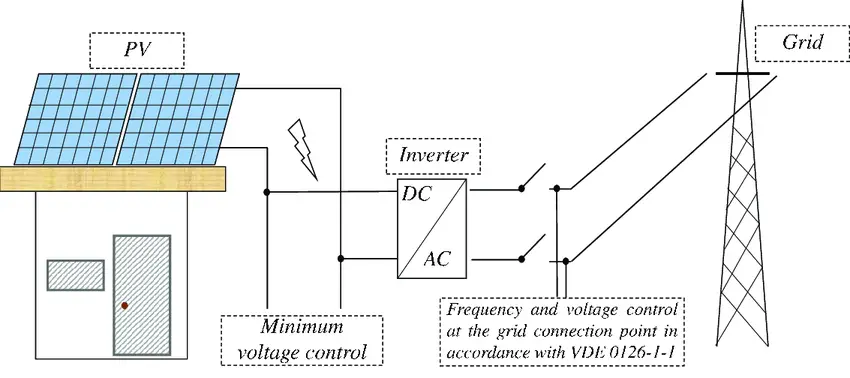
Grid-connected PV systems are installations in which surplus energy is sold and fed into the electricity grid. On the other hand, when the user needs electrical power from which the PV solar panels generate, they can take energy from the utility company.
In the case of adapting these installations in a building, it will incorporate a new electrical installation and now have two different electrical installations. On the one hand, the usual electricity supply line and, on the other hand, the photovoltaic solar installation.
The grid-connected self-consumption photovoltaic installation scheme is as follows:

What is PV energy?
We define PV energy as the energy obtained from solar radiation converted into electricity through the photoelectric effect.
It is a type of renewable energy that leads to the consumption of electricity is more efficient.
Therefore, PV panels are responsible for transforming the energy from the sun's radiation into electricity, thanks to the photovoltaic effect. As a result, different power levels can be achieved depending on the connection between the panels.
Thus, these PV modules can be used both to supply electricity to large urban areas and for individual self-consumption.
How do PV plants work?
Solar panels can be used autonomously to generate electricity at home and on a large scale to supply urban centers and industries.
For this, we need to connect PV modules that allow obtaining high levels of electrical power. This type of installation is called a photovoltaic (PV) plant.
PV plants are designed to respond to high electricity demands, thanks to their array of solar panels. And how do these facilities work? Very simple: PV panels are composed of solar cells that transform the sun's energy into electrical energy, specifically direct current.
Later, solar inverters transform this direct current into alternating current, which finally passes to the electrical grid.
Advantages of a grid-connected solar PV system
The benefits of this system are:
-
No electrical energy is lost.
-
Using this system, batteries are not required to store energy.
-
Since solar energy is renewable energy, all energy generated is energy that won’t be generated using fossil fuels.
-
The user can consume electricity when needed regardless of the amount of energy generated by the solar panels.
-
The landlord charges money for electricity bills fed into the utility grid supply company.
Where are grid-connected solar systems used?
Some of the applications of these photoelectric solar energy systems are the following:
-
In roofs, terraces, etc., of homes, in case these buildings have a connection to the electrical grid: The roof surface is used to place modular systems that are easy to install.
-
Power plants have an industrial nature. They can be installed in rural areas not used for other uses (such as solar farms) or superimposed on large roofs in urban areas (car parks, commercial areas, etc.)
-
Integration in buildings: It consists of replacing conventional architectural elements with new items that include PV elements. Sometimes, it is possible to combine them with architectural designs to take advantage of passive solar energy or with solar thermal energy systems.
What is the working electrical power?
The most common powers measured in watts are 2.5 and 5 kilowatts (kW) or multiples of 5 up to 100 kW. There are larger solar installations, but companies or research centers only carry them out since they are amortized over extended periods.
PV solar power systems of up to 5 kilowatts (kW), being low power systems, can be connected to the low voltage single-phase grid at a nominal voltage of 230 volts in alternating current. On the other hand, for higher powers, they are designed with a three-phase connection.
In the solar part, there are different possible voltage configurations in the series-parallel connections of the PV modules to obtain suitable work values in direct current.
Depending on the power inverter chosen, the working voltages can be from 12 volts to 600 volts in direct current. In any case, to optimize the system, medium voltages close to the grid connection voltages (260-420 VDC) are tended to.
How is the photovoltaic installation connected to the grid?
To develop the connection, particular emphasis must be placed on minimizing the losses derived from the connections, both in direct and alternating currents.
The steps to connect these systems to the systems required follow these steps:
-
Interconnection of PV modules.
-
Connection of modules to power inverters.
-
Connection of the inverters in the protection panel and energy meters
-
Connection of the power to the grid point.
Interconnection equipment
In each facility, we must install an interconnection panel with the grid. This panel may include the total of the protection devices defined by the regulations or those established as essential.
On the other hand, this equipment may include net metering and voltage transformers for adaptation to the utility grid voltage.
At this point, the connections derived from the different electrical inverters and electrical generators are brought together. It is the connection point of the entire system.
Grid connection point
Electric companies establish points of interconnection with the grid. In this type of system, the connection points will usually be defined and located in parallel with the connection already installed for the consumption of the building or the established construction.
General rules of application to define a perfect union in the electrical grid:
-
The maximum power of the photovoltaic plant cannot exceed more than 50% of the transformer's nominal power or the electrical substation's capacity of the same grid defined in the connection area.
-
Connections of installations that produce electrical voltage drop caused by the connection and disconnection greater than 2% will not be accepted.
The protection cabinets and connection panel have the function of including the instruments for measuring the energy produced and consumed, as well as the electrical protections (automatic action devices) required by current regulations.